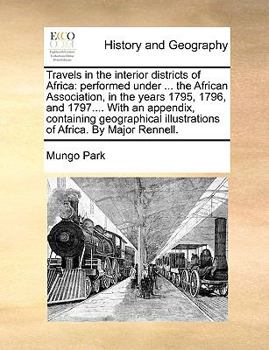Travels in the interior districts of Africa: performed under ... the African Association, in the years 1795, 1796, and 1797.... With an appendix, cont
Select Format
Select Condition 
Book Overview
A combination of two journeys, Scotsman Mungo Park's story of his first trip in 1795 as a 24-year old, and again in 1805, provided Europeans with their first reliable description of the interior of... This description may be from another edition of this product.
Format:Paperback
Language:English
ISBN:1170029310
ISBN13:9781170029312
Release Date:June 2010
Publisher:Gale Ecco, Print Editions
Length:536 Pages
Weight:2.09 lbs.
Dimensions:1.1" x 7.4" x 9.7"
Customer Reviews
3 ratings
Fascinating journey to old Africa
Published by Thriftbooks.com User , 16 years ago
I have just finished reading the Kindle version of this book, and found it fascinating reading. Mr. Park is an amazing explorer. The story of his initial adventures is amazing and humbling. He really was a persistent guy! Worth reading for the insights to slavery as it existed in those days, as well as traveling both as a priveleged white man and later as a fugitive. The Kindle version works well and was cheap. I doubt I could have found this book readable or affordable in its initial form.
The Intrepid Mungo Park
Published by Thriftbooks.com User , 21 years ago
Kate Ferguson Marsters' edition of Mungo Park's TRAVELS is an excellent example of the travel narrative - easily comparable with the Journals of Lewis & Clark or Francis Parkman's OREGON TRAIL. The book is broken into three parts: Park's travel narrative , Marsters' Introduction & Major Rennell's Geographical Illustrations Of Mr. Park's Journey (which is rather dry and dated).The main work is a narrative of Park's travels from Barra, on the West African coast, to the town of Silla, just west of Jenne and his return to the western coast. Park provides many interesting details and asides, including that of Mumbo Jumbo (also mentioned by Francis Moore) for disciplining wayward wives. Park also spends a fair amount of time explaining local governments and social norms. Throughout, the account attempts some degree of neutrality while noting acts of kindness and avarice by various individuals and rulers; although, not surprisingly, he explicitly criticizes the Moors who continually interfered with his progress and those who robbed and stripped him. Perhaps his most disturbing account is of the female slave who becomes too sick to continue traveling with the coffle. The entire work puts black slaves and their families in a very sympathetic light and shows the slave trade at its worst; although, due to the continuing conditions of slavery and internal conquest pre-dating major European involvement in the trade, Park stated that the termination of the Trans-Atlantic slave trade would not provide as great a benefit to the populace in Africa as many hoped.The Introduction is important in providing the history of Park's early years, the important role of the African Association and its leader, Sir Joseph Banks. More importantly the Introduction deals with the Bryan Edwards controversy. Richard Burton and Orlando Patterson's criticisms have held that internal African slavery and slave trading was not nearly so prevalent as suggested by Park. In light of this, Marsters' statement that Joseph Banks, a critic of slavery, had to approve every piece of Edward's editing becomes extremely important. In addition, it is made clear that the reason for the stylistic differences is that the original TRAVELS was a book derived from Park's notes whereas the published work of his second, ill-fated journey was merely a compilation of those notes retrieved from the dead man's party! All-in-all, an excellent and informative read!
Mungo Park is one of the overlooked adventurers.
Published by Thriftbooks.com User , 27 years ago
Mungo Park (1771-1806?) was the first European to visit the Niger River basin in 1796. He resolved, once and for all, a debate that had European cartographers and geographers confused for centuries. His initial journey (1795-1797) was a tale of tremendous personal hardship and suffering, but triumph in the end. After returning to Scotland in 1798, he became acquainted with Sir Walter Scott. They became close friends, and it was Sir Walter Scott who convinced him to return to Africa to encover the secret of the mouth of the Niger River. In 1805 he convinced the British government, in the middlle of a war against Napoleon, to send another expedition to seek out the mouth of the Niger. With 100 officers and men he set out, retracing his earlier steps. The journey was filled with personal tragedy and heroism. After arriving on the Niger, he built a boat, named the Joliba, and travelled down the river. During the course of his journey he met and traded with the many kingdoms that lined the river. However, he also incurred the wrath of many local kings and chiefs who believed that he was cheating them. Near the town of Bussa (now covered by a huge dam), Mungo Park met his unexpected end. For many years it has been assumed that he was attacked by hostile natives seeking to rob him. In fact it may have been due to the fact that he just failed to navigate the river





